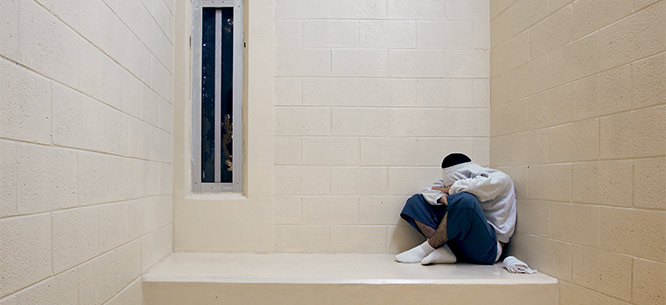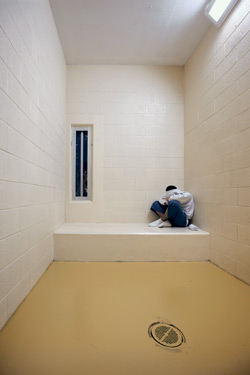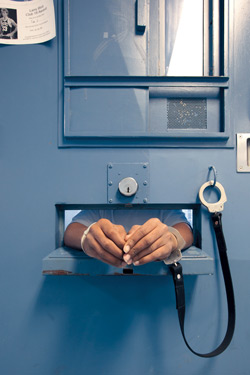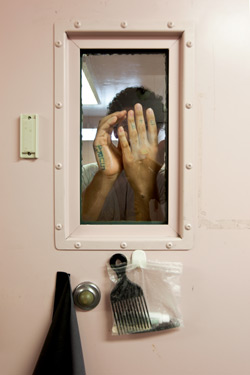The Rise of Solitary
The Rise of Solitary
In the early 1990s Pelican Bay Prison was a cesspool of brutality. But in ending its worst years, did a judge civilize the cruel practice of solitary confinement?

23/7: Pelican Bay Prison and the Rise of Long-Term Solitary Confinement
by Keramet Reiter
Yale University Press, 2016, 312 pp.
At the end of 1989, a few weeks after the Berlin Wall came down, the state of California opened its first supermax facility. The Pelican Bay State Prison, built in a remote territory near the Oregon border, contains more than a thousand cells designed for solitary confinement. The annual cost of keeping a prisoner in one of these cells: about $70,000, or 126 percent of the median U.S. household income.
The California Department of Corrections rejects the term “solitary confinement,” instead calling Pelican Bay’s supermax cells “Security Housing Units,” or SHUs. But see if this sounds like solitary confinement to you: until conditions eased slightly after hunger strikes in 2011 and 2013, Pelican Bay’s SHU prisoners spent twenty-two-and-a-half hours per day in their eighty-square-foot cells. They were released only for brief showers or to exercise—alone—in windowless indoor “dog runs.” Phone calls were permitted only to receive news of family deaths. If they wanted physical contact with another human being, the only way to get it was to provoke the guards into restraining or beating them.
In settings like Pelican Bay, even the most resilient people tend to develop psychiatric symptoms: anxiety, paranoia, obsessive-compulsive rituals. Suicides are far more common in isolation units than in standard prison settings. In the 1890 U.S. Supreme Court case In re Medley, the majority reviewed the reasons why American prisons had abandoned solitary confinement half a century earlier: “A considerable number of the prisoners fell, after even a short confinement, into a semi-fatuous condition . . . and others became violently insane.” But those lessons were eventually forgotten.
In 23/7: Pelican Bay Prison and the Rise of Long-Term Solitary Confinement, the scholar and advocate Keramet Reiter sets out to explain why and how supermax prisons emerged in the United States around 1990. She also asks a parallel, in some ways more unsettling, question: How have Pelican Bay and other supermax prisons gotten away with being so institutionally opaque? Until Reiter herself forced the issue several years ago, the state of California compiled and released almost no data about which prisoners were assigned to SHU units, and for how long, and why. In an era when politicians and journalists fetishize data, transparency, and accountability, our jails and prisons have managed to remain black boxes. And if they’ve been this opaque under center-left governments, we can only imagine what will happen in the age of Trump.
In Pelican Bay’s case, the lack of transparency is especially jarring. The prison was the subject of a 60 Minutes exposé in 1993, and it entered into a high-profile consent decree with a federal judge two years later. Despite all that attention, fundamental aspects of the prison’s operations remained effectively secret until 2008, when Reiter began to file open-records requests. If you wanted to know why your son or brother was transferred into solitary, or how long he might be there, good luck getting answers.
60 Minutes visited Pelican Bay in 1993 for a simple reason: in its earliest years, the prison was a cesspool of brutality. Despite the fact that the prison was ostensibly built to isolate prisoners in single-bed cells, it soon exceeded its capacity, and prisoners were double-bunked. Wardens officially documented 683 cell fights, a few of which left prisoners paralyzed or comatose. Between the prison’s opening and mid-1993, guards fired their weapons 177 times. Three prisoners were killed by that gunfire, two of whom were allegedly not the guards’ intended targets. In 1992 an African-American prisoner who had smeared himself with feces was forced into a tub of scalding water with his hands cuffed behind him, suffering burns so severe that he went into near-fatal shock. A prison nurse testified that she heard a guard quip, “Looks like we’re going to have a white boy before this is through.”
Pelican Bay’s worst years ended in 1995, when U.S. District Judge Thelton Henderson issued a ruling that restricted guards’ use of force and demanded minimal decency in medical care and mental health services at the prison. At the same time, Henderson’s ruling did not challenge the constitutionality of long-term solitary confinement. Nor did it find fault with the opaque and arbitrary methods that California prison officials used to determine which prisoners deserved to be placed in supermax cells. In tandem with similar judicial actions elsewhere, Henderson’s ruling had the effect of legitimizing long-term solitary confinement—a practice that hadn’t been widespread in the United States since the mid-nineteenth century. As Reiter puts it: “Did Judge Henderson civilize hell?”
Roughly between 1995 and 2011, when hunger strikes opened a new period of reform, Pelican Bay was no longer nakedly brutal. Instead, it became something coolly inhuman. Overt violence declined, but prisoners continued to endure the effects of solitude, often for years on end. SHUs comprise only 10 percent of California’s cells, but more than 70 percent of the state’s prison suicides take place in such units. One ex-SHU prisoner testified in 2013 about his post-release life: “It took my partner five years before she could touch me without it hurting me.” Another told Reiter that he continued to suffer panic attacks in small crowded spaces: he could tolerate supermarkets with wide aisles, but not coffee shops.
Reiter, who teaches law at the University of California at Irvine, is a longtime prison-rights activist, but this book is no sermon. Instead, she has tried to dispassionately explain the political, institutional, and legal dynamics that have led solitary confinement to take the forms it has taken in the United States. Without a sober understanding of those dynamics, she suggests, no movement against solitary will succeed.
First, Reiter examines the political dynamics. At first glance, it’s no surprise that supermaxes began to emerge in 1989. The crack epidemic was near its peak, and the U.S. murder rate was spiking. It was the year of the Central Park jogger case, the year when Donald Trump took out bloody-minded newspaper ads: “BRING BACK THE DEATH PENALTY. BRING BACK OUR POLICE!”
 |
 |
 |
As Reiter demonstrates, however, you can’t draw a straight line between populist law-and-order fervor and the rise of solitary. The public may have wanted offenders locked away, but there was no particular popular demand for solitary confinement as such. Nor did California lawmakers insist on it. Pelican Bay was quietly designed by entrepreneurial administrators within California’s prison bureaucracy, with only token legislative oversight. To truly understand the emergence of places like Pelican Bay, you need to get inside the heads of prison wardens, not the heads of state senators.
For people like Carl Larson, the California prison bureaucrat who was the principal designer of Pelican Bay, long-term solitary confinement was meant to solve two problems. The first was the officially declared rationale for solitary: it is intended to reduce prison deaths by isolating the most dangerous people in the system. (Here the results are mixed, according to data compiled by Reiter: California’s prison homicide rate declined slightly between 1989 and 2006, but the suicide rate increased. Both rates are far below their early 1970s peaks.)
The second, less publicly discussed rationale was to restore wardens’ discretionary powers, which had been eroded by a series of legal changes in the 1970s and 1980s. Until 1976, California criminal law used a system of indeterminate sentencing, in which prison administrators and parole boards had enormous discretion to extend sentences as punishment for bad behavior. (An armed robbery conviction might lead to a sentence of “one year to life.”) As Quaker activists demonstrated in a series of reports in the early 1970s, the practice of indeterminate sentencing was arbitrary and racist. But after the 1976 sentencing reform was enacted, wardens felt they had much less leverage to maintain order inside their buildings.
The wardens found a solution in solitary confinement, which was used informally throughout the state after 1976 and then systematically after the 1989 unveiling of Pelican Bay. Reiter describes the wardens’ logic with some sympathy, even though she finds the outcome horrific: “The ‘prisons within prisons’ were necessary, they felt, to maintain control over the entire imprisoned population. Bad behavior required consequences: however bad prison was, there had to be someplace worse. Prison was not enough.”
Wardens no longer had the power to indeterminately extend prison sentences—but they could assign prisoners to SHUs for indeterminate lengths of time within their sentences. One of the primary mechanisms for doing this was to designate a prisoner as a gang member. The evidence required for such designations was slim: Reiter recounts the story of a prisoner she refers to as Ernie, who was placed in a SHU cell in 2003 after being “validated” as a member of the Aryan Brotherhood on the basis of a drawing found by guards. At that time, you needed six years of spotless behavior before you could appeal a gang designation. But in 2008, a year before he would have been eligible, Ernie’s gang status was revalidated when guards found him in possession of a brain-teaser book (Matching Wits With Mensa) with the name of another alleged Aryan Brotherhood member inscribed inside the front cover. That was enough to revalidate Ernie. His six-year clock was reset to zero.
When Pelican Bay prisoners began their initial hunger strike in 2011—an astonishing feat of organizing given their constraints—their first demands had to do with wardens’ discretion to designate prisoners as gang members. In their formal statement of grievances, reforms to the “gang validation” system were placed higher on the list than greater access to sunlight or health care.
The strikers won that demand. In 2012 the state announced that it would review prisoners’ SHU designations statewide. That process moved tortuously slowly, however, until a second hunger strike was organized in 2013. This one lasted for two months and, at its apex, involved 30,000 prisoners across California. The state legislature finally agreed to hold hearings and the Department of Corrections agreed to accelerate its review process. Of the first 528 cases the state reviewed, only thirty-five prisoners were deemed to require long-term placement in a SHU unit. Overall, more than a thousand California SHU prisoners were moved back to the general prison population—or in many cases released outright—in 2013 and 2014.
The California prison hunger strikes rival Black Lives Matter and Occupy Wall Street among the most audacious dissident movements of the Obama era. Their victories were not pure products of direct action, of course. The strikes were organized in the setting of a class-action federal lawsuit filed by two Pelican Bay prisoners and later supported by the Center for Constitutional Rights. (Without communication via lawyers, the hunger strikes would have been almost impossible to coordinate.) And they had crucial help from left-wing allies in the California legislature.
Reiter ends on a note of pessimism about whether the California reforms will be sustained. Prison administrators, she reminds us, have strong incentives to maintain their discretionary powers. “They want to maximize their repository of tools with which to keep prisons both safe and silent—and full,” she writes. “These goals are fundamentally at odds with humanitarian reforms.”
Reiter wrote those words several months before the November election. If her pessimism was justified then, it is all the more so now. The man who promised, “Would I approve waterboarding? You bet your ass I would. In a heartbeat” now has his hands on the U.S. Justice Department and its over $28 billion budget.
The practice of solitary confinement—which Charles Dickens famously denounced as “worse than any torture of the body”—will probably only take deeper root during the Trump years. But Reiter’s book, for all its sobriety and pessimism, is an effective counsel against despair. Despite the neglect and contempt of their state’s center-left and center-right establishments, California prisoners and their allies painstakingly built a movement, and in the last five years they’ve won real victories. May their endurance be a model for us all.
David Glenn is an oncology nurse in Maryland. He was associate editor of Dissent from 1995–1999.




